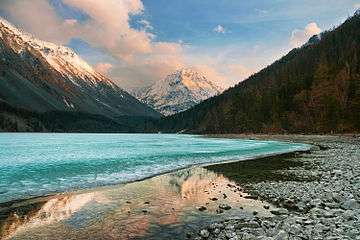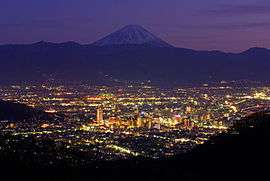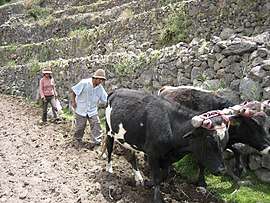Mountain research
Mountain research or montology, traditionally also known as orology[1] (from Greek oros ὄρος for 'mountain' and logos λόγος), is a field of research that regionally concentrates on the Earth's surface's part covered by mountain landscapes.



Mountain areas
Different approaches have been developed to define mountainous areas. While some use an altitudinal difference of 300 m inside an area to define that zone as mountainous,[2] others consider differences from 1000 m or more,[3] depending on the areas' latitude. Additionally, some include steepness to define mountain regions, hence excluding high plateaus (e.g. the Andean Altiplano or the Tibetan Plateau), zones often seen to be mountainous. A more pragmatic but useful definition has been proposed by the Italian Statistics Office ISTAT, which classifies municipalities as mountainous
- if at least 80% of their territory is situated above ≥ 600 m above sea level, and/or
- if they have an altitudinal difference of 600 m (or more) within their administrative boundaries.[4]
The United Nations Environmental Programme has produced a map[5][6] of mountain areas worldwide using a combination of criteria, including regions with
Focus
Broader definition
In a broader sense, mountain research is considered any research in mountain regions: for instance disciplinary studies on Himalayan plants, Andean rocks, Alpine cities, or Carpathian people. It is comparable to research that concentrates on the Arctic and Antarctic (polar research) or coasts (coastal research).
Narrower definition
In a narrower sense, mountain research focuses on mountain regions, their description and the explanation of the human-environment interaction in (positive) and the sustainable development of (normative) these areas. So-defined mountain research is situated at the nexus of natural sciences, social sciences and humanities. Drawing on Alexander von Humboldt's work in the Andean realm, mountain geography and ecology are considered core areas of study; nevertheless important contributions are coming from anthropology, geology, economics, history or spatial planning. In sum, a narrowly defined mountain research applies an interdisciplinary and integrative regional approach. Slaymaker summarizes:
The science of montology [...] starts with recognition of the importance of verticality, a distinctive feature of mountain regions, which imposes vertical control of the production system; marginality, which results from low agricultural potential; centrality of mechanisms of power and violence; population growth and expansion; and religion and myth, expressed in mountains as sacred places. Montology emphasises restoration ecology to include re-vegetation, rehabilitation, reclamation and recovery of the lost landscape form and function [...]. Landscape ecological effects are arranged along altitudinal belts and form the basis for a more comprehensive understanding of critical habitats for conservation and development. This approach has an underlying assumption of climax communities each fitting into a narrow altitudinal band.[7]
Denomination
Mountain research or orology—not to be confused with orography—, is sometimes denominated montology. This term stems from Carl Troll's mountain geoecology—geoecology being Troll's English translation of the German Landschaftsökologie—and appeared at a meeting in Cambridge, Massachusetts in 1977.[8] Since then, scholars such as Jack D. Ives, Bruno Messerli and Robert E. Rhoades have claimed the development of montology as interdisciplinary mountain research. The term montology was included in the Oxford English Dictionary in 2002.[9] It defines montology as:
The study of mountains; specifically the interdisciplinary study of the physical, chemical, geological, and biological aspects of mountain regions; (also) the study of the lifestyles and economic concerns of people living in these regions.[10]
On the one hand, the term montology received criticism due to the mix of Latin (mōns, pl. montēs) and Greek (logos). On the other hand, however, this is also the—well accepted—case in several, already established disciplines such as glaciology or sociology.
Mountain research journals
The following list includes peer-reviewed journals that have a focus on mountain research and are open to both the natural and the social sciences:
| Journals covered by citation indices | |
|---|---|
| Mountain Research and Development |
|
| Journal of Mountain Science |
|
| Journal of Alpine Research / Revue de géographie alpine |
|
| eco.mont |
|
| Appalachian Journal |
|
| Revista de Investigaciones Altoandinas |
|
| Pirineos |
|
| Histoire des Alpes – Storia delle Alpi – Geschichte der Alpen |
|
| HIMALAYA |
|
| Устойчивое развитие горных территорий / Sustainable Development of Mountain Territories |
|
| Journals not covered by citation indices | |
| Bulletin de l’Institut français d’études andines |
|
| Himalayan Journal of Sciences |
|
| Revista Andina |
|
| L’Italia Forestale e Montana / Italian Journal of Forest and Mountain Environments |
|
| Beskydy – The Beskids Bulletin |
|
| Journal of Mountain Agriculture on the Balkans |
|
| Mountain Research |
|
Mountain research personalities
|
|
See also
- Mountain Research and Development
- Journal of Mountain Science
- eco.mont – Journal on Protected Mountain Areas Research and Management
- Mountain Partnership
Further reading
- Borsdorf, A.; Braun, V. (2008). "The European and Global Dimension of Mountain Research: An Overview". Revue de géographie alpine. 96 (4): 117–129. doi:10.4000/rga.630.
- Debarbieux, B.; Price, M. F. (2008). "Representing Mountains: From Local and National to Global Common Good". Geopolitics. 13 (1): 148–168. doi:10.1080/14650040701783375.
- Ives, J. D.; Messerli, B. (1999). "AD 2002 Declared by United Nations as "International Year of the Mountains"". Arctic, Antarctic, and Alpine Research. 31 (3): 11–213. doi:10.2307/1552249. JSTOR 1552249.
References
- http://www.merriam-webster.com/dictionary/orology Merriam Webster
- Borsdorf, Axel (2014). "Editorial". Eco.mont (Journal on Protected Mountain Areas Research). 5: 3–4. doi:10.1553/eco.mont-5-1s3.
- http://www.unep.org/maweb/documents/document.293.aspx.pdf Mountain Systems. UNEP
- http://www.istat.it/it/archivio/147760 Precisazione sulla classificazione dei comuni montani
- http://www.arcgis.com/home/webmap/viewer.html?useExisting=1&layers=0a5d90defc33466cbc3eb85a6564b6d6 UNEP-WCNC (2011): Mountains of the World – 2000. Map
- http://old.unep-wcmc.org/mountains-and-forests-in-mountains-2000_723.html UNEP-WCNC (2011): Mountains of the World – 2000. Data
- Slaymaker, O (2007). "The potential contribution of geomorphology to tropical mountain development: The case of the MANRECUR project". Geomorphology. 87 (1–2): 90–100. Bibcode:2007Geomo..87...90S. doi:10.1016/j.geomorph.2006.06.044.
- Neustadtl, SJ (1977). "Montology: the Ecology of Mountains". Technology Review. 79 (8): 64–66.
- "New words list December 2002".
- "Montology | Meaning of Montology by Lexico".
